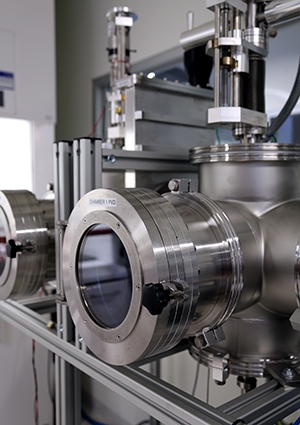'Father' of plasma research has visited Deakin
Research news
After nearly 50 years in plasma research, Professor Riccardo D’Agostino is still excited about plasma. Professor D’Agostino, from the University of Bari, Italy, is one of the world’s foremost experts on plasma and has just completed a three-month visit to Deakin’s Institute for Frontier Materials, as Thinker-in-Residence.
Professor D’Agostino has been at the centre of plasma research since 1968, when its potential was only being discovered by the infant computer industry.
Its use is now widespread across many industries, yet Prof D’Agostino believes that scientists are only at the cusp of understanding its benefits. He argues that plasma, which is the most common matter in the universe - found in lightning, the sun and other stars - and features unique properties, such as high electrical conductivity and non-equilibrium state, has much more to offer humanity.
“With plasma, we can change the surface characteristics of a material,” Professor D’Agostino explained.
“Every solid material has a surface that can potentially be modified by plasma. Its ionising effect results in new particles that change the surface to give very different characteristics. A material can be made more wettable or perfectly unwettable; strongly adhesive or repellent.”
He noted that plasma can now be used to create a super-hydrophobic surface, where water doesn’t even touch the surface of a material. This could be used to create self-cleaning or anti-ice surfaces that could improve aircraft safety, or low-friction surfaces that could improve the performance of ships, for instance.
He explained that the current new trend in plasma research concerns exploring the use of plasma directly on living matter, such as inside the body, for wound healing or reducing blood clots, or on the skin, for treating skin cancer or aiding skin regeneration, for instance.
During his visit to Deakin, Professor D’Agostino has conducted seminars for students and staff, and worked on the development of new industrial applications of plasma technology with Dr Jane Dai, leader of Deakin’s Plasma Research Laboratory, with whom he has collaborated for the past 11 years.
Dr Dai explained that Deakin’s plasma research focusses on the development of new plasma methodologies and technologies to address industrial challenges and to provide a technology platform for research at the University.
The Deakin research includes tailoring of surfaces/interfaces to achieve new functionality, and the fabrication/doping of nanomaterials, to produce better performing materials, for sectors ranging from energy, biomedicine, food and agriculture, to nanotechnology, composites, transport and textiles.
Current plasma research projects at Deakin include: improving solar cell and battery performance; sterilising milk to improve shelf-life and maintain nutrient quality; the development of chemical-free fertilisers for plant growth, using plasma treated water that contains nitrite and other components that plants require; plasma treatment of seeds for sterilization and to increase water absorption for healthy germination; making lighter and stronger composite materials, by surface coating of nanoparticles and sizing of carbon fibres; and developing conductive textiles that provide performance feedback and biomonitoring, for use in sport and medicine.
As well as being Bari University’s Professor of Chemistry, Prof D’Agostino is also the President of its spin-off company, Plasma Solution, which uses low temperature, low pressure plasma to develop plasma applications with industry.
His honorary positions include: Editor-in-Chief of the international journal “Plasma Processes and Polymers;” Fellow of the International Plasma Chemistry Society; and former President of the International Plasma Chemistry Association.
During his visit, Professor D’Agostino has also worked with staff from the lab to help local small and medium enterprises benefit from plasma technology. He and Dr Dai gave presentations to a Deakin "Workshop on Industrial Applications of Plasma Technology" to introduce plasma technology for industrial applications. Deakin plasma capabilities were showcased and it was explained how industrial challenges could be met. This forum allowed local industry to discuss problems and research needs and begin collaboration.
The visit also triggered strong interest from the Italian national institutions in Australia, including the Embassy in Canberra and the General Consulate in Melbourne, and Prof D’Agostino believes that it is likely that Italy will support a workshop on Plasma Technology for Industrial Applications, to be held in conjunction with an international Plasma Conference in Geelong that is to be chaired by Dr Dai in 2016.
“Jane and I are also trying to set the basis of a long-lasting collaboration on plasma science between our two universities. We are, in fact, promoting a Memorandum of Understanding as an indispensable tool for managing the collaboration,” said Professor D’Agostino.
The exchange of knowhow with Deakin has been “very fruitful,” he added. “In the past, scientists stayed in their respective fields. My background is in plasma chemistry, while Jane’s is in plasma physics, but the science has evolved and many disciplines now explore plasma. Today, we are all plasma ‘scientists.’”
Share this story
 Deakin's Plasma Research Laboratory features state-of-the-art plasma technology.
Deakin's Plasma Research Laboratory features state-of-the-art plasma technology.
